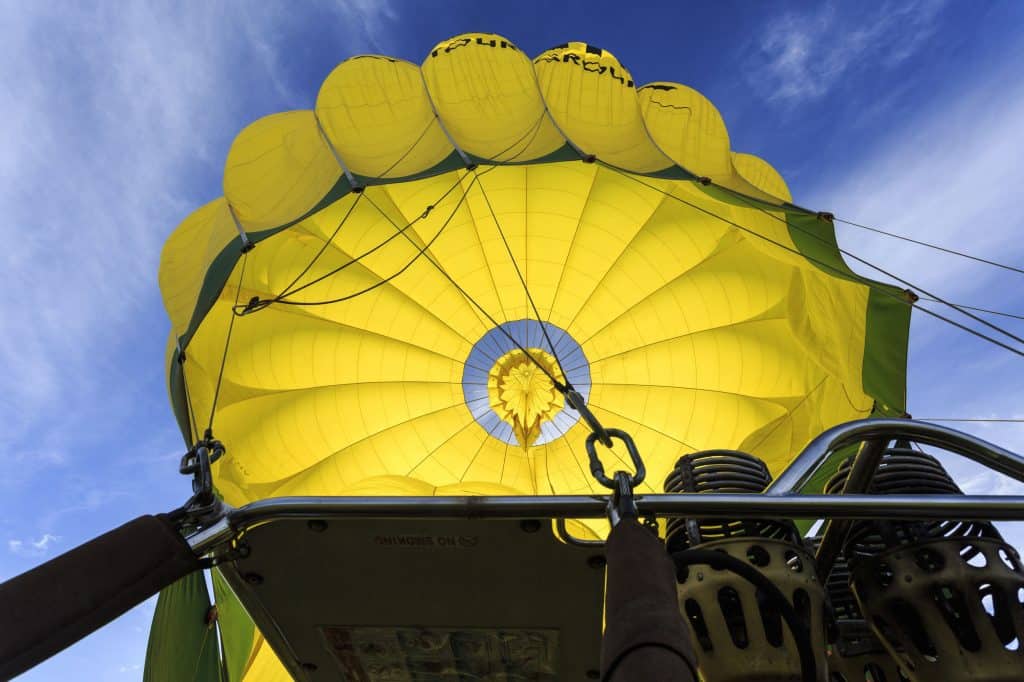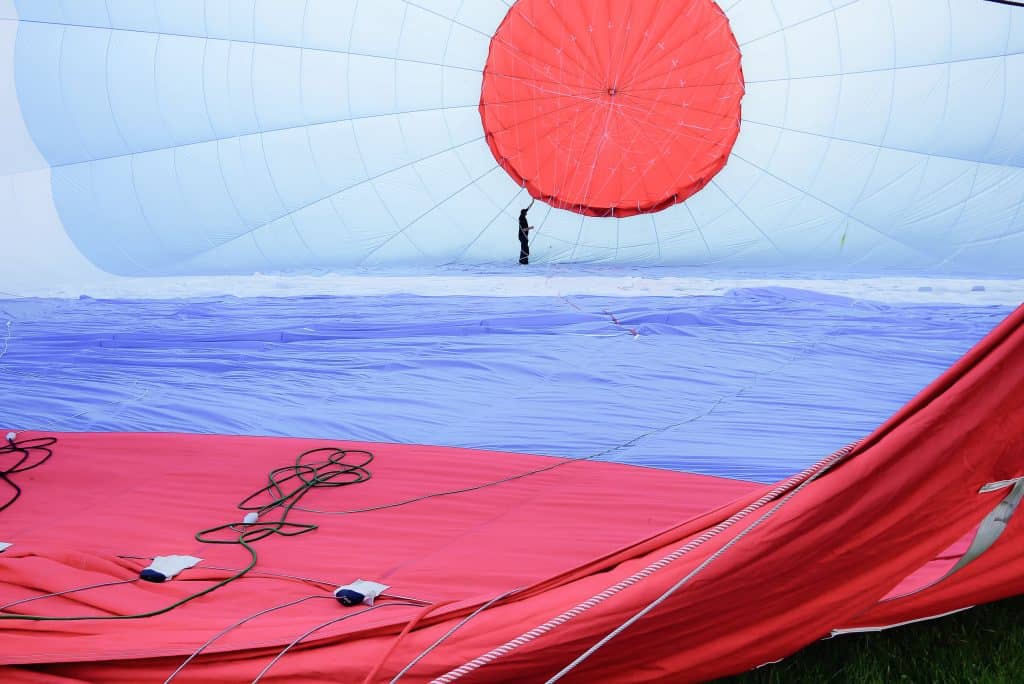
Hot air balloons are proof that science does not make sense. I mean, they’re huge nylon sacks with a hole on bottom and on top that somehow still fly. So what exactly is that hole doing on the top of a hot air balloon?
The hole on top of a hot air balloon’s envelope is called the parachute valve. When opened, it allows hot air to escape causing the balloon to descend. The pilot can open the parachute valve by pulling on a cord that goes from the valve to the basket. Otherwise, the valve remains closed, trapping the hot air inside the envelope.
Really, the parachute valve is one of the most genius parts of a hot air balloon. Before its addition to balloon design, pilots just had to land when physics said so!
How it Works
There is both beauty and power in simplicity. As odd and obtuse as hot air balloons are, they are very simple. To me, that makes them both simple and powerful.
The parachute valve is really, really simple. In fact, it’s one of those inventions that now seems pretty obvious. Did no one really think of this earlier?
Well, that’s the way it goes with simplicity. Sometimes humans are inclined towards trying to find grand, genius solutions. The parachute valve is a testament to the fact that sometimes grand and genius is simple.
Early hot air balloons had a problem: landing was hard. Like, really hard.
To land, the pilot just waited for the air in the envelope to cool down. That meant there was virtually no way to control the speed of descent when you wanted to land.
Of course, these early hot air balloons soon fell out of popularity for other reasons. They weren’t really the safest invention ever. But eventually, hot air balloons were poised to make a return!
But the issue lingered: how do we get more control over the landing process? The answer was simple. Put a hole in the top of the envelope.
Of course, there’s more to it than that. I said it was simple, but not that simple. Let’s look at the mechanics of how the parachute valve works below.
The Mechanics

Putting a hole in the top of the envelope, also called the crown, was a great idea! Just like there was a hole on the bottom that allowed hot air in, it made sense to have a hole on the top that let hot air out!
But you needed a way to control how much hot air left the envelope. You see, that hot air was the only thing keeping the whole balloon in the air! So letting it out as soon as it came in just wouldn’t do.
So what was to be done? Make it a really small hole? Put netting on it? Just put hot air into the envelope really really fast?
Well, once again, the answer was simple. Keep the hole covered until you wanted to let hot air out. If you wanted to go up, the hot air was stuck in the envelope! But when you wanted to go down, you could just uncover the hole!
But then there was another problem. How do you cover and uncover the hole? Most hot air balloons are pretty darn tall, so it would be kind of hard for a pilot to reach the top of the envelope.
Plus, to get to the top you have to pass the burners. Ouch!
The answer? A simple pulley and lever like system. A cord attached to the parachute valve goes all the way to the basket. When you pull on the chord, the valve opens. When you aren’t pulling the chord, the valve stays closed.
And that’s hot the parachute valve works! It’s really that simple! Pull the chord to let hot air out, don’t pull it to keep the hot air in!
Why it Works
Knowing how the parachute valve works is great and all, but how does it work? Well, unlike how the parachute valve works, why it works is much more complicated.
We’ll keep it really simple though! If you graduated from middle school, you should have no problem with this. If you haven’t graduated from middle school, you aren’t old enough to be on the internet alone yet!
Most great inventions and discoveries are made while trying to solve a problem. The parachute valve is a great example, but so is the science behind the parachute valve!
Below we’ll discuss how buoyancy was discovered and how it relates to the parachute valve on a modern day hot air balloons!
Archimedes’ Discovery

The story goes that long ago in ancient Greece there was a King who wanted a new crown. There was about to be a new temple built, and he wanted to look his best for the ceremony!
He commissioned a local goldsmith to use one of his gold lumps (which is not a disease) to make the new crown. After a few days, the goldsmith returned a beautiful crown!
But there were rumors that the goldsmith mixed the gold with other metals to make it more pliable. This was displeasing to the King, so he asked the local know-it-all, Archimedes, to figure out the truth!
Archimedes reasoned that an object placed in water would displace the same amount of water no matter how the object was shaped!
So Archimedes took the crown and one of the King’s other gold lumps (still not a disease) and placed them into tubs of water. It was time to see whether or not the crown had extra metals mixed in!
The crown caused more water to overflow the tub than the gold lump, and thus everyone knew the goldsmith had added other metals to the crown!
Buoyancy and Balloons

The principle that Archimedes discovered is now called Archimedes’ principle, or the law of buoyancy.
Archimedes principle states that an object completely or partially submerged in a fluid (liquid or gas) is acted upon by an upward force equal to the amount of fluid displaced by the object.
That’s why a ball of lead sinks straight to the bottom of the pool, but humans can float. We might weigh more than lead, but we also displace more liquid than lead. Thus, the upward force acting on us is greater than the force working on the ball of lead!
As long as the upward force (buoyancy) and the downward force (gravity) are equal, an object floats. If the downward force is greater, it sinks. If the upward force is greater, it flies!
That’s exactly what happens in a hot air balloon. All the air inside the envelope rises when heated. Because it’s trapped inside the envelope, it pulls on the whole balloon.
When the upward force becomes greater than the downward force, the balloon flies! But what about when you want to land?
Well, the downward force needs to become greater than the upward force. You could just wait for the air to cool down, but then you can’t control your descent. That’s where the parachute valve comes in!
When you’re ready to land, you can let hot air escape in “bursts” from the envelope. This allows you to control how much upward force there is.
You can keep the upward force just slightly weaker than the downward force, and therefor you’ll slowly descend. Eventually, you’ll land safely!
Does it Actually Work?
You may be asking yourself right now: does that actually work the way this guy says it works? That sounds kind of sketchy.
To answer your question: absolutely! It works wonderfully! If you don’t believe me, just consider the thousands, perhaps even millions, of hot air balloons that have landed safely using a parachute valve!
In fact, hot air ballooning is an incredibly safe activity, and parachute valves make it even safer! This excellent invention is one of many that has propelled hot air ballooning into popular culture in modern times.
You no longer have to wonder how on earth a hot air balloon can fly with two massive holes in it!
